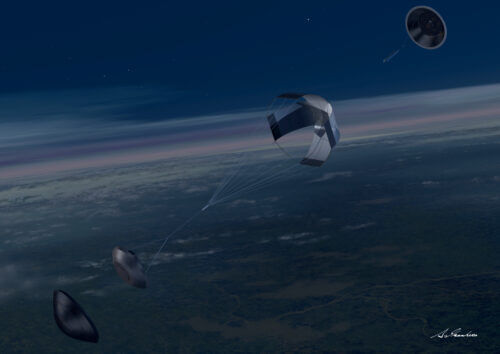The Yabusa 2 spacecraft itself continued on its way and will meet with another asteroid in 2031

Japan's Yabusa 2 probe passed by Earth on Dec. 5 and dropped a capsule containing pieces of an asteroid, ending a six-year round trip. But the mission is far from over: As Hybosa 2's parachute-equipped sample capsule plummeted in the Australian deserts, its mother ship moved onto a new trajectory that would take it to a rendezvous with another asteroid in 2031.
Yabusa 2's main purpose was to deliver pieces of soil from the asteroid Ryugo, which is currently 11.6 million km from Earth. Mission controllers at Japan's space exploration agency, JAXA, cheered when news arrived that the capsule had survived re-entry into the atmosphere.
Images captured by surveillance cameras — and the International Space Station — showed the capsule creating a fireball across the sky as it slowed from an initial speed of 43,000 km/h.
The searchers went out by helicopter to locate the 40 cm wide capsule in the Wammera test area in South Australia. The capsule was found within a few hours. We found the capsule! Along with the parachute! “Wow, that was amazing. Yabusa 2 crew members at the Japanese Space Agency reported on Twitter.
New insights into carbonaceous asteroids
The sample is expected to amount to no more than a few grams, but it will be intensively studied in laboratories in Japan and the USA to reveal new insights about carbonaceous asteroids that are thought to be the basis from which the planets were formed and which also contained the chemical building blocks of life.
Yabusa 2's predecessor, the original Japanese probe Yabusa (later Yabusa 1) sampled a different type of asteroid named Itokawa in 2005. The return flight of Yabusa 1 was fraught with difficulties, primarily propulsion and communication problems that caused the delay in bringing the sample until 2010, in total there were about 1,500 asteroid dust samples in the sample. This time, the mission went more smoothly. Four years after its launch in 2014, Yabusa 2 carried out the rendezvous with Ryugu, sending a series of mini rovers to the surface to scout and collect pieces of rock and dust.
The probe began its journey home a little over a year ago, and encountered no problems along the way. Hours before the scheduled landing, the Hayabusa 2 mothership released the sample capsule into its target orbit and returned to deep space.
Thanks to this maneuver, Yabusa 2 is expected to meet with a water-rich asteroid known as 1998 KY26 in 2031. This asteroid is much smaller than Ryogo - it is 30 meters wide, compared to Ryogo's 900 meters wide. It also rotates on its axis every 10 minutes or so.
But we won't have to wait 11 years for the next asteroid sample to arrive: NASA's OSIRIS-REx spacecraft collected up to 2 kg of material from asteroid Benu in October, and is set to drop its sample capsule to a test site in Utah in 2023.
It should be noted that in the coming days a large sample of the lunar soil is supposed to land on Earth by the Chinese spacecraft Chang'e 5, which it excavated last week.
More of the topic in Hayadan:

One response
Father, is there an update regarding the Chinese spaceship? (The last paragraph of the article) Did she manage to bring the soil samples from the moon?